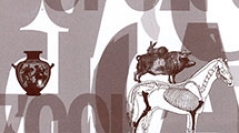

 Anthropozoologica
43 (1) - Pages 43-66
Anthropozoologica
43 (1) - Pages 43-66Stone tool hafting has been a widely discussed topic, but its identification on a prehistoric level has long been hampered. Given the organic nature of hafting arrangements, few remains are generally preserved. An overview is presented of animal materials that can be used for hafting stone tools, and examples are provided of preserved hafting arrangements made out of animal raw material. Based on the same principles as those determining the formation of use-wear traces on stone tools, it is argued that hafting traces are formed and can be identified. The variables influencing the formation of hafting traces are discussed. Specific wear patterns and trace attributes are provided for different hafting arrangements that use animal raw material. It is concluded that the provided referential data allow for the identification of hafted stone tools on prehistoric sites and the identification of the hafting arrangement used.
Stone tools, use-wear, hafting, wear pattern, experiments, animal raw material.